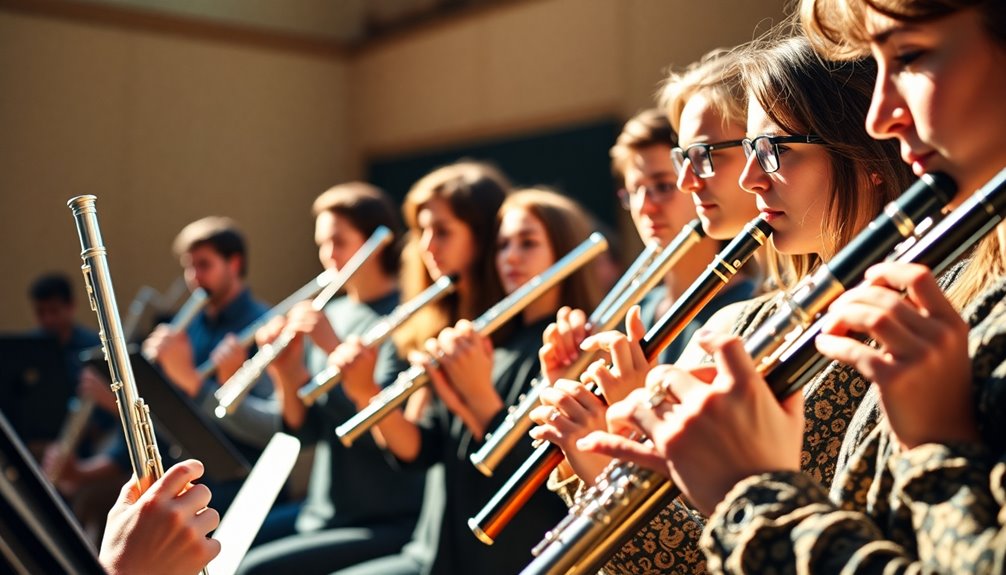Flute choirs are unique ensembles that combine different flutes—like piccolos, concert flutes, alto flutes, and bass flutes—to create a rich, layered sound. Each instrument adds its own character, from the bright melodies of the piccolo to the warm tones of the concert flute and the deep resonance of the bass flute. This blend fosters dynamic interactions among players, enhancing emotional connections. Mastery of breath control and dynamic range is key to a cohesive performance. With a diverse repertoire—from classical to contemporary—flute choirs offer an engaging musical experience. Explore how these elements enrich the artistry of flute ensembles.
Key Takeaways
- Flute choirs consist of various flute types, including piccolo, concert flute, alto flute, and bass flute, creating a rich and diverse sound.
- The ensemble's unique textures and harmonics evoke a range of emotions, enhancing listeners' connections through intricate musical layers.
- Mastery of breath control and dynamic range is essential for achieving unity and blending within the ensemble during performances.
- A diverse repertoire, spanning classical to contemporary works, enriches the group's artistic expression and engages audiences effectively.
- Participation fosters a strong sense of community, encouraging personal growth, collaboration, and lasting friendships among musicians.
History of Flute Choirs

Flute choirs have a rich history that traces back several centuries, evolving alongside the development of the flute itself. The origins of the flute can be found in ancient cultures, where simple wooden instruments played a crucial role in communal music-making.
As the flute underwent transformations, so did its role in ensembles. By the late Renaissance and into the Baroque period, flutes became increasingly popular in chamber music settings, leading to the formation of early flute ensembles. These groups typically featured different types of flutes, showcasing their unique timbres and harmonies.
As the 18th century progressed, the ensemble evolution continued, with composers writing specifically for flute choirs, expanding their repertoire and enhancing their artistic expression. The introduction of the modern concert flute significantly influenced the sound and structure of these ensembles, allowing for greater versatility and expressiveness.
In the 19th century, the flute's design improved, giving rise to the modern concert flute. This development further encouraged the establishment of flute choirs in conservatories and community groups, fostering a sense of belonging among flutists.
Today, flute choirs remain vibrant, reflecting their historical roots while embracing contemporary compositions. Whether you're a seasoned player or just starting out, joining a flute choir can connect you with a rich tradition of musical collaboration and creativity.
Instrumentation and Flute Family

Often, flute choirs incorporate a diverse range of instruments from the flute family, creating a rich tapestry of sound. This ensemble typically includes various flute types, such as the piccolo, concert flute, alto flute, and bass flute. Each instrument plays a unique role within the family, contributing to the overall harmony and texture of the music.
The piccolo, with its bright and piercing sound, often takes on the melody, leading the choir with energetic lines. In contrast, the concert flute provides a warm, lyrical foundation, filling in the mid-range harmonies. The alto flute, with its deeper tone, adds depth and richness, while the bass flute anchors the ensemble with its resonant, low register.
Together, these flute types create a vibrant blend, showcasing the versatility of the flute family. As you explore this ensemble, you'll discover how each instrument complements the others, enhancing the overall musical experience. The inclusion of instruments like the alto flute enriches the ensemble with its unique resonant voice.
This collaboration fosters a sense of belonging, inviting you to appreciate the unique roles each flute plays in the ensemble's collective sound. Embrace the beauty of flute choirs and the diverse instrumentation that makes them truly special.
Unique Sound and Texture

Within a flute choir, the unique sound and texture emerge from the harmonious interplay of its various instruments. Each member, from the piccolo to the bass flute, contributes distinct tonal colors, creating a rich tapestry of sound.
You'll find that flute harmonics play a vital role in this ensemble. These harmonics add depth, allowing for intricate layers that enhance the overall listening experience.
The ensemble dynamics in a flute choir are equally impressive. As musicians, you'll learn to blend your individual voices, steering through soft passages and powerful crescendos together. This unity fosters a sense of belonging, as you collectively create a sound that's greater than the sum of its parts.
The gentle swells and dips in volume invite listeners on an emotional journey, showcasing the versatility of the flute family.
Moreover, the unique textures produced by combining different flute registers can evoke various moods, from serene to exhilarating. You'll discover that this dynamic range not only captivates audiences but also nurtures a profound connection among the players. Mastery of articulation techniques enhances the emotional connection with the audience and allows for expressive performance.
Fundamentally, the unique sound and texture of a flute choir foster an inviting atmosphere where everyone feels valued and included.
Performance Techniques

Mastering performance techniques is essential for achieving the full potential of a flute choir. To truly connect with your fellow musicians and create a cohesive sound, you need to focus on breath control. This skill helps you maintain steady tone and pitch, allowing for smoother shifts between notes. Practicing long tones and breath exercises will enhance your ability to support the ensemble.
Another essential aspect is understanding dynamic range. In a flute choir, you'll often find yourself maneuvering between delicate whispers and powerful crescendos. It's important to listen actively to your peers, adjusting your volume to blend harmoniously. By doing so, you foster a sense of unity that elevates the overall performance.
Additionally, consider your articulation techniques. Whether you're using staccato or legato, clarity in your playing will make the ensemble's sound more vibrant and expressive. Moreover, developing diaphragmatic breathing techniques allows for better air control, which is crucial for maintaining sound quality during long passages.
Repertoire for Flute Choirs

When it comes to selecting repertoire for flute choirs, you'll want to immerse yourself in a diverse range of musical styles and compositions. This variety not only enriches your experience but also enhances the ensemble dynamics, allowing each member to contribute uniquely.
Start by exploring classical flute arrangements, which often showcase intricate harmonies and counterpoints. Pieces by composers like Bach or Mozart can offer both challenge and reward.
Don't shy away from contemporary works, either. Modern compositions can introduce exciting rhythms and textures that resonate with today's audiences. Look for pieces that incorporate extended techniques, as these can highlight the versatility of the flute.
You'll also want to reflect on arrangements of popular songs and folk tunes, as these often engage listeners and create a sense of familiarity. Additionally, consider incorporating diverse repertoire that can promote a well-rounded skill set within the ensemble.
Collaborating with your choir members to select repertoire can foster a sense of belonging and unity.
Benefits of Playing in a Choir

Playing in a flute choir offers numerous benefits that extend beyond just musical enjoyment. One of the most significant advantages is the social benefits you gain from connecting with fellow musicians. In a choir, you're part of a community that shares your passion for music, fostering friendships that can last a lifetime.
Moreover, playing in a flute choir enhances your teamwork skills. You'll learn to collaborate closely with others, listening and adjusting your playing to blend harmoniously. This experience teaches you how to communicate effectively and appreciate the contributions of every member.
As you practice and perform together, you'll develop a sense of camaraderie that enriches your musical journey. The shared goals and achievements create a supportive environment where everyone feels valued.
Additionally, playing in a group challenges you to improve your individual skills, as you'll be motivated by your peers. The feedback and encouragement you receive can propel you to new heights in your musicianship. Furthermore, the collaborative practice leads to continuous growth and overall skill enhancement, allowing you to explore new musical boundaries.
Ultimately, the benefits of participating in a flute choir extend well beyond music, creating a sense of belonging that enriches your life both personally and artistically.
Frequently Asked Questions
How Do Flute Choirs Differ From Traditional Orchestras?
Flute choirs differ from traditional orchestras primarily in instrumentation and repertoire.
In a flute choir, you'll find a range of flutes, including piccolos, alto, and bass flutes, creating a unique sonic texture. The repertoire often focuses on pieces specifically arranged for this ensemble, showcasing the versatility of the flute family.
You're likely to experience a more intimate, cohesive sound compared to the broader orchestral experience, fostering a sense of connection among players and listeners.
Are Flute Choirs Suitable for Beginners?
Did you know that over 60% of flute players start in a group setting? Flute choirs are perfect for beginners!
They allow you to practice essential beginner flute techniques while feeling a sense of belonging. The collaborative environment fosters learning and growth, helping you develop your skills with others.
Plus, flute choir benefits extend beyond technique; you'll build friendships and enjoy music-making in a supportive community, making it an ideal choice for new players.
What Types of Venues Host Flute Choir Performances?
Flute choirs often perform in a variety of venues that enhance audience engagement, such as concert halls, community centers, and outdoor festivals.
These performance spaces not only provide excellent acoustics but also foster a sense of connection among attendees. Your presence in these settings can create a vibrant atmosphere, allowing you to experience the beauty of the music while connecting with fellow listeners.
Each venue offers a unique opportunity to enjoy the art of flute performance.
Can Flute Choirs Perform Pop or Contemporary Music?
Imagine the air shimmering with the vibrant sounds of a flute choir, transforming familiar melodies into something magical.
Yes, flute choirs can absolutely perform pop arrangements and contemporary adaptations. By infusing popular tunes with their unique sound, you'll create an engaging experience that resonates with audiences.
Whether it's a beloved hit or a modern classic, these ensembles breathe new life into the music, inviting everyone to join in the celebration through shared enjoyment.
How Can I Start a Flute Choir in My Community?
To start a flute choir in your community, begin by recruiting members through local music schools, community centers, or social media.
Create an engaging flyer to attract fellow flutists.
Once you've gathered enough interest, organize rehearsals at a convenient location, like a community hall or a park.
Set a regular schedule to foster commitment and camaraderie.
Conclusion
In the world of music, flute choirs are like a gentle breeze, weaving together a tapestry of sound that captivates the heart. By exploring their rich history and unique instrumentation, you discover a vibrant community that fosters creativity and collaboration. Whether you're performing or simply listening, the enchanting melodies and intricate textures remind us of the beauty in unity. So, if you've ever considered joining a flute choir, take the leap—you'll find joy and growth in every note.





